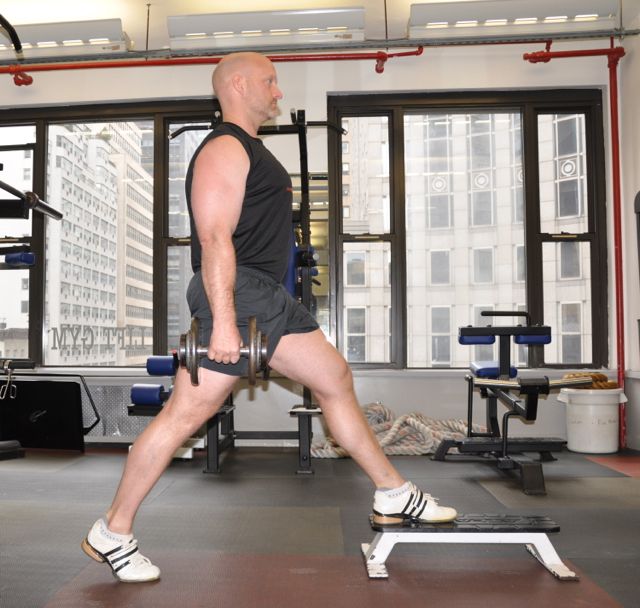Dumbbell Split Squat Front Foot Elevated
Anatomy of the DB Split Squat Front Foot Elevated
The Dumbbell Split Squat is an excellent exercise to improve the strength of the quadriceps, medial hamstrings, and adductors. The exercise also helps to re-establish normative flexibility of the hip flexors, specifically the iliopsoas and the rectus femoris.
The hip flexor muscles become chronically shortened in populations who sit for a living. This adaptive shortening leads to dysfunction in the hips and the knees, and is a leading source of lower back pain. In sports that require sprinting ability, inadequate flexibility of the hip flexors inhibits the action of the glutes in hip extension, robbing you of power and ultimately, speed.
Split squats can be particularly challenging for the beginning exerciser, who may have neither the strength nor the flexibility to descend to the full depth of the range of motion. The answer to addressing this challenge lies in elevating the front foot on a step, as shown in the images that follow.
Though we shot the exercise with a minimum of elevation, you may elevate the front foot as high as the knee to perform the exercise if necessary. When higher than shown elevation of the front foot is necessary to perform the exercise, we recommend split squatting with body weight only, until strength improves sufficiently to decrease the height of the step as shown below – to about 4-6 inches.
Instruction of the DB Split Squat Front Foot Elevated
To begin the exercise, start with bodyweight. Difficulty can be increased in subsequent sets with the use of dumbbells, as shown in Step 1.

At the beginning of the exercise, place the hands on the hips (or hold DB’s as shown), and place the front foot on an appropriate height step. Step backward with the support leg, and assume the starting position: front foot flat; rear foot articulated (on the ball of the foot), back leg as straight as possible.

Inhale as you descend into the range of motion. During the descent, keep the rear leg as straight as your flexibility will allow, and maintain an upright posture. Drive the front knee forward of the toes, until the hamstrings cover the calves.

At the bottom of the range of motion, begin exhaling, and reverse the movement. Keep the back leg straight, and push the front foot into the step until you are at the top of the movement.
Tips for DB Split Squat Front Foot Elevated
- Keep the back leg extended as far as your flexibility will allow during both descent and ascent. The rear leg serves as the pivot point of the movement, and if you do not maintain a fixed position of the knee, you will tend to “float” in a no man’s land during the movement.
- Maintain a heel up position in the rear leg. Doing so will improve your pivot point.
- Keep the torso and the core upright. Hip extension – the backward movement of the rear leg during the exercise – comes from the hip, not the core or the torso. Bending forward is cheating, and often occurs when you are too tight to perform the exercise properly. Conversely, excessively flexible exercisers may appear to maintain an upright torso, but may actually allow their core to collapse backward, rather than forcing the iliopsoas of the hip to elongate properly.
- Maintain a heel down position on the front leg. Part of the goal of the exercise is to teach you to squat properly, so the development of proper ankle flexibility is crucial to the ultimate success of the exercise.
- Do not be afraid of driving the front knee forward of the toes. The concept that this is dangerous to the knee joint is a myth in lower body training. Though its explanation is beyond the scope of this instruction, a knees forward of the toes position is a natural position of the lower limb that becomes lost to us as muscles of the ankle, knee, and hip adaptively shorten through inactivity and improper training. Should a well meaning but uninformed individual advise you against performance of the split squat in this fashion, thank them for their concern, and get back to work.
- Watch the video below for a look at properly-performed split squats. Notice that, although my flexibility does not allow for a completely straight rear leg, the leg position specific to my rear knee is largely fixed throughout the movement. When the knee does bend, it only occurs in the descent, and straightens out during the ascent to provide a solid pivot point.
DB-Split-Squat-Front-Foot-Elevated-video-running-strength-training-New-York-City-personal-training
NYC Personal Training
Physiqology is a personal training company based in New York City. We offer a sustainable system of personal fitness training through the seamless integration of exercise, flexibility training, diet and supplementation.




